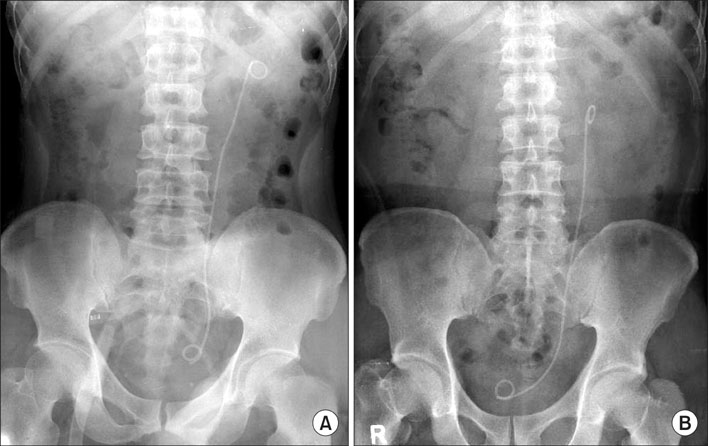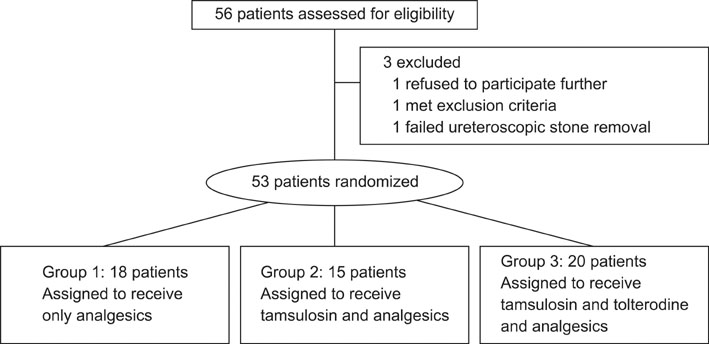Korean J Urol.
2010 Sep;51(9):636-641.
Stent Position Is More Important than alpha-Blockers or Anticholinergics for Stent-Related Lower Urinary Tract Symptoms after Ureteroscopic Ureterolithotomy: A Prospective Randomized Study
- Affiliations
-
- 1Department of Urology, College of Medicine, Hallym University, Chuncheon, Korea. js315@hallym.or.kr
Abstract
- PURPOSE
To evaluate the clinical factors that impact ureteral stent-related lower urinary tract symptoms (LUTS) after ureteroscopic ureterolithotomy, including the stent position and medication.
MATERIALS AND METHODS
Fifty-three patients who underwent ureteroscopic ureterolithotomy with indwelling a stent were distributed into three groups. On demand analgesics were given to the group 1 (n=18). Daily tamsulosin 0.2 mg was added for group 2 (n=15) and daily tamsulosin 0.2 mg and tolterodine 4 mg was added for group 3 (n=20). The patients were also subclassified into appropriate or inappropriate group according to stent position. All the patients completed a visual analogue scale (VAS) and International Prostate Symptom Score (IPSS) on the 1st and 7th postoperative days. The VAS and IPSS were analyzed according to the medication groups and the stent position.
RESULTS
In the appropriate stent potion group, only the storage symptom scores of groups 2 and 3 on the 1st postoperative day were significantly lower than those of the group 1 (p=0.001). This medication effect on LUTS was not observed in the inappropriate stent position group. In this group, total IPSS (p=0.015) and storage symptom scores (p=0.002) were higher than in the appropriate stent position group on the 7th postoperative day.
CONCLUSIONS
Correct placement of the stent was more important than medication for lessening stent-related storage symptoms.
Keyword
MeSH Terms
-
Adrenergic alpha-Antagonists
Analgesics
Benzhydryl Compounds
Cholinergic Antagonists
Cresols
Humans
Lower Urinary Tract Symptoms
Phenylpropanolamine
Prospective Studies
Prostate
Stents
Sulfonamides
Ureter
Ureteroscopy
Urinary Catheterization
Urological Manifestations
Tolterodine Tartrate
Adrenergic alpha-Antagonists
Analgesics
Benzhydryl Compounds
Cholinergic Antagonists
Cresols
Phenylpropanolamine
Sulfonamides
Figure
Reference
-
1. Zimskind PD, Fetter TR, Wilkerson JL. Clinical use of long-term indwelling silicone rubber ureteral splints inserted cystoscopically. J Urol. 1967. 97:840–844.2. Joshi HB, Stainthorpe A, MacDonagh RP, Keeley FX Jr, Timoney AG, Barry MJ. Indwelling ureteral stents: evaluation of symptoms, quality of life and utility. J Urol. 2003. 169:1065–1069.3. Pilcher JM, Patel U. Choosing the correct length of ureteric stent: a formula based on the patient's height compared with direct ureteric measurement. Clin Radiol. 2002. 57:59–62.4. Al-Kandari AM, Al-Shaiji TF, Shaaban H, Ibrahim HM, Elshebiny YH, Shokeir AA. Effects of proximal and distal ends of double-J ureteral stent position on postprocedural symptoms and quality of life: a randomized clinical trial. J Endourol. 2007. 21:698–702.5. Shibasaki M, Sudoh K, Inagaki O, Uchida W, Honda K. Effect of the optical isomers of YM-12617 on increased intra-urethral pressure induced by phenylephrine in anaesthetized dogs. J Auton Pharmacol. 1992. 12:263–268.6. Chung DE, Te AE. Tolterodine extended-release for overactive bladder. Expert Opin Pharmacother. 2009. 10:2181–2194.7. Kaplan SA, Roehrborn CG, Rovner ES, Carlsson M, Bavendam T, Guan Z. Tolterodine and tamsulosin for treatment of men with lower urinary tract symptoms and overactive bladder: a randomized controlled trial. JAMA. 2006. 296:2319–2328.8. Chew BH, Knudsen BE, Denstedt JD. The use of stents in contemporary urology. Curr Opin Urol. 2004. 14:111–115.9. Thomas R. Indwelling ureteral stents: impact of material and shape on patient comfort. J Endourol. 1993. 7:137–140.10. Deliveliotis C, Chrisofos M, Gougousis E, Papatsoris A, Dellis A, Varkarakis IM. Is there a role for alpha1-blockers in treating double-J stent-related symptoms? Urology. 2006. 67:35–39.11. Damiano R, Autorino R, De Sio M, Giacobbe A, Palumbo IM, D'Armiento M. Effect of tamsulosin in preventing ureteral stent-related morbidity: a prospective study. J Endourol. 2008. 22:651–656.12. Beddingfield R, Pedro RN, Hinck B, Kreidberg C, Feia K, Monga M. Alfuzosin to relieve ureteral stent discomfort: a prospective, randomized, placebo controlled study. J Urol. 2009. 181:170–176.13. Wang CJ, Huang SW, Chang CH. Effects of tamsulosin on lower urinary tract symptoms due to double-J stent: a prospective study. Urol Int. 2009. 83:66–69.14. Park SC, Jung SW, Lee JW, Rim JS. The effects of tolterodine extended release and alfuzosin for the treatment of double-J stent-r elated symptoms. J Endourol. 2009. 23:1913–1917.15. Joshi HB, Newns N, Stainthorpe A, MacDonagh RP, Keeley FX Jr, Timoney AG. Ureteral stent symptom questionnaire: development and validation of multidimensional quality of life measure. J Urol. 2003. 169:1060–1064.
- Full Text Links
- Actions
-
Cited
- CITED
-
- Close
- Share
- Similar articles
-
- Impact of loop-tail ureteral stents on ureteral stent-related symptoms immediately after ureteroscopic lithotripsy: Comparison with pigtail ureteral stents
- Clinical Outcome in Male Patients With Detrusor Overactivity With Impaired Contractility
- Is the 3-day Stenting Sufficient for Ureteroscopic Lithotripsy?
- A Study on the Efficacy of Combination Therapy with Alpha-blockers and Anticholinergics in the Lower Urinary Tract Symptoms Patients Accompanied with Overactive Bladder Symptoms
- Is intravesical stent position a predictor of associated morbidity?



